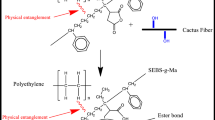Influence of the content of hemp fibers (harvested in 2012) and their modification methods (treatment with boiling water, sodium hydroxide, and acetic anhydride) and addition of an interfacial modifier, maleated polyethylene (MAPE), on the performance characteristics (tensile strength, modulus, elongation at break, microhardness, and water resistance) of composites based on a linear low-density polyethylene (LLDPE) was investigated. The results obtained are compared with data found earlier for the same type of hemp fibers, but harvested in 2011. It is shown that optimum content of untreated hemp fibers in the LLDPE matrix is 30 wt.% and optimum length of the fibers is less than 1 mm. An increase in the content of hemp fibers (to 30 wt.%) raised the tensile strength and modulus of the composites, but reduced their elasticity and deformation ability. Simultaneously, the microhardness of the composite materials grew. Pretreating the fibers with sodium hydroxide improved the mechanical properties of the composites only slightly, but treating with acetic anhydride allowed us to elevate the content of the fibers up to 40 and 50 wt.%. The best results were achieved by addition of 50 wt.% MAPE, when the tensile modulus increased by about 47% and the tensile strength by 27% as compared with those of composites with fibers pretreated by other methods. To estimate the processing possibilities of the composites, the melt flow index (MFI) was determined. It is established that the pretreatment of the fibers significantly affects the numerical values of MFI. For example, upon treatment with acetic anhydride, a sufficiently high fluidity of the composites was retained even at a 50 wt.% content of fibers. The lowest fluidity was observed for composites with alkali-pretreated hemp fibers. The surface microhardness decreased upon their chemical pretreatment. The highest microhardness showed composites with 30 wt.% untreated fibers. The chemical pretreatment considerably raised the water resistance of the composites. Especially low water absorption was observed for composites containing MAPE and hemp fibers pretreated with acetic anhydride.


Similar content being viewed by others
References
R. Solizenko, J. Kajaks, O. Nestore, and S. Kukle, “The exploitation properties of hemp fibers containing linear low density polyethylene composites,” Sci. J. Riga Techn. Univ., Mater. Sci. Appl. Chem., 27, 17-21 (2013).
O. Nestore, J. Kajaks, I. Vanchovica, and S. Reihmane, “Physical-mechanical properties of composites based on linear low density polyethylene and natural fiber textile waste,” Mech. Compos. Mater., 48, No. 6, 897-910 (2012).
D. Nwabunma and T. Kun (eds.), Polyolefin Composites, Wiley and Son Inc. Publ. (2007), pp. 44-86.
G. Bekerman, “Performance of Hemp Fibers Reinforced Polypropylene Composite Materials,” in: Research Conmon Satthe University of Waikato (2007), pp. 2-18.
A. R. Sanadi, D. F. Caulfield, and R. E. Jacobson, “Agro-fiber thermoplastic components,” in: Paper and Composites from Agro-Based Resources, Lewis Oblication//Obligation (1997), pp. 377-401.
D. Pasquinini, E. M. Teixeira, A. A. Curvelo, et al., “Surface esterification of cellulose fibers: processing and characterization of low density polyethylene/cellulose fibers composites,” Compos. Sci. Technol., 68, No. 1, 193-201 (2008).
K. J. Lee, A. Delille, and A. Bismarck, “Greener surface treatments of natural fibers for the production of renewable composite materials,” in: B. Susheel Kalia, S. Kaith, and Inderjeet Kaur, Cellulose Fibers: Bio- and Nano-Polymer Composites, Green Chemistry and Techology, Springer, Berlin (2011), pp. 156-158.
S. Kalia, K. Thakure, A. Cellia, et al., “Surface modification method of plant fibers using environment friendly methods for their applicaton in polymer composites, textile industry and antimicrobical activities: A review,” J. Environm. Chem. Eng., 1, Iss. 3, 97-112 (2013).
N. Ozmen, “Vinylacetilation of hemp fibers,” Bioresources, No. 7 (3), 3800-3809 (2012).
V. Kumar, L. Tyagi, and S. Sinha, “Wood flour-reinforced plastics composites: A review,” Rev. Chem. Eng., 27, Nos. 5/6, 253-264 (2011).
S. Panigrahi, X. Li, L. Tabil, K. Barghout, R. L. Kushwaha, and E. K. Mupoudwa, “Development of flax fiber reinforced biocomposites for potential application for automotive industries,” SAE Int. J. Commerc. Vehicles, 2, No. 2, 107-114 (2010).
B. Wang, L. Tabil, and S. Panigrahi, “Effects of chemical treatments on mechanical and physical properties of flax fiber-reinforced composites,” Sci. Eng. Compos. Mater., 15, No. 1, 43-57 (2010).
B. Wang, S. Panigrahi, and L. Tabil, “Pretreatment of flax fibers for use in rotational moulded biocomposites,” J. Reinf. Plast. Compos., 26, No. 5, 447-463 (2007).
F. Marli-Ferrer, F. Vilaplana, A. Ribes-Greens, et al., “Flour rice husk as filler in block copolymer polypropylene: Effects of different coupling agents,” J. Appl. Polym. Sci., 99, No. 4, 1823-1831 (2009).
Author information
Authors and Affiliations
Corresponding author
Additional information
Translated from Mekhanika Kompozitnykh Materialov, Vol. 51, No. 5, pp. 955-964, September-October, 2015.
Rights and permissions
About this article
Cite this article
Kajaks, J., Zelca, Z. & Kukle, S. The Effect of Modification Methods on the Performance Characteristics of Composites Based on a Linear Low-Density Polyethylene and Natural Hemp Fibers. Mech Compos Mater 51, 677–682 (2015). https://doi.org/10.1007/s11029-015-9538-z
Received:
Revised:
Published:
Issue Date:
DOI: https://doi.org/10.1007/s11029-015-9538-z



